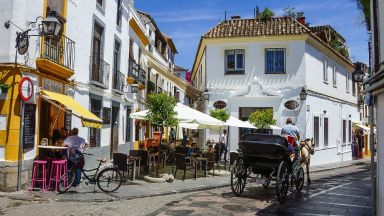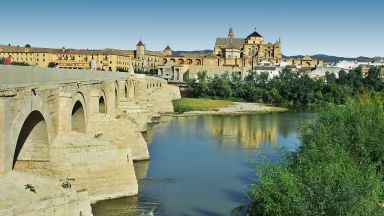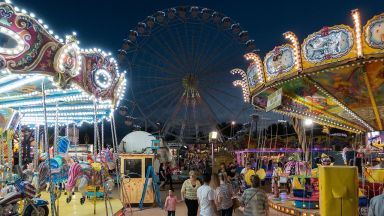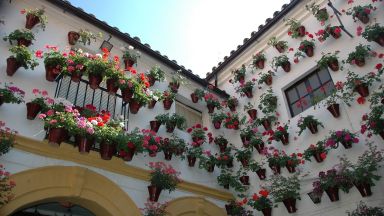Judería de Córdoba
Area in Córdoba

The Judería de Córdoba or the Jewish Quarter of Córdoba, is an area of the city of Córdoba in Andalucia where the Jews lived between the 10th and 15th centuries. its official name is Distrito Sur or the Southern District, it’s the heart of old Cordoba, and is one of the best places to stay in Cordoba Spain during your stay.
Short history of the Judería de Córdoba
Córdoba went through a period when three peoples (Christian, Jewish and Muslim) and their respective religions lived together, albeit, the non-Muslim population living subjugated under Islamic Law with Jews having their own court system.
What does the Judería quarter look like?
Everyday, tourists from all over the world discover the Judería’s major paths making parts of this quarter a crowded and busy spot. However, beyond this hustle and bustle, there are execrated corners and narrow winding alleyways making a stroll worthwhile. There you may find lovely whitewashed houses and magnificent balconies and courtyards overflowing with colorful blooms. The Judería quarter with its typical Andalusian maze of alleyways is the most distinguished and enchanting area in town. In 1984, Unesco declared the entire quarter, including its landmarks such as the Mezquita or the Royal Fortress, as world cultural heritage of mankind. At all times, particularly under the power of Abd al-Rahman III., the Judería had been the very intellectual and cultural center of the entire region.
What can you see in the Judería de Córdoba?
Besides the Mosque, you can see monuments such as the Sinagoga (Synagogue), the Zoco Municipal (Zoco Municipal Market) or the Museo Taurino (Bull-fighting Museum), among others.
The Jews were established in Cordoba in roman and Visigothic times and formed a brilliant intellectual group when Hasfay Ibn Shaprut, Abdul al Rahmm III, Jewish councilor attracted intellectuals to the court.
The Juderia is now known for the jewelers and silversmiths shops.
Córdoba’s old Jewish quarter consists of a fascinating network of narrow lanes, more atmospheric and less commercialised than in Seville although souvenir shops have emerged.
North and west of the Grand Mosque is the city’s Jewish quarter, which retains the street-plan it had as a ghetto hundreds of years ago.
The Jews were expelled from Spain in the late-15th century, but during the Caliphate Córdoba’s Jewish population thrived and it was home to Maimonides, the 12th-century Sephardic polymath.
In the 21st century it’s quite a posh part of the city, home to the Calleja de las Flores (little street of flowers), and true to its name it’s fragrant and colourful at any time of year.
The main indication that there was a Jewish population is the Synagogue, one of only three left in Spain.
What to see in the Judería de Córdoba
- Judería de Córdoba: Located in the heart of Córdoba’s Jewish Quarter, and just blocks away from the Mezquita, lies the Sinagoga de Córdoba. Built in the 14th century, the small synagogue houses a courtyard, prayer room, and women’s gallery.
- Mezquita-Catedral de Córdoba: The Mezquita of Cordoba is one of the world’s most impressive buildings making it one of the most remarkable tourist attractions both in Cordoba and Spain.
- Plaza Maimónides: Plaza Maimónides is a small square located in the middle of the Jewish Quarter. It Houses the Bullfighting Museum and a statue of the Jewish philosopher Maimónides.
The Judería de Córdoba appears in our Complete Guide to Visiting Córdoba!
This website uses affiliate links which may earn a commission at no additional cost to you!
Visiting Judería de Córdoba
24 Hours
Free
Nearby Attractions
- Casa de Sefarad (0.0) km
Museum in Córdoba - Sinagoga de Córdoba (0.0) km
Synagogue in Córdoba - Casa Andalusí (0.0) km
Historic Building and Museum in Córdoba - El Zoco (0.0) km
Market in Córdoba - Maimonides Statue (0.1) km
Statue in Córdoba - Museo Taurino de Córdoba (0.1) km
Museum in Córdoba - Capilla de San Bartolomé (0.1) km
Church in Córdoba - Plaza Maimónides (0.1) km
Square and Statue in Córdoba - Almodóvar Gate (0.1) km
City Gate in Córdoba - Hospital del Cardenal Salazar (0.1) km
Historic Building in Córdoba


